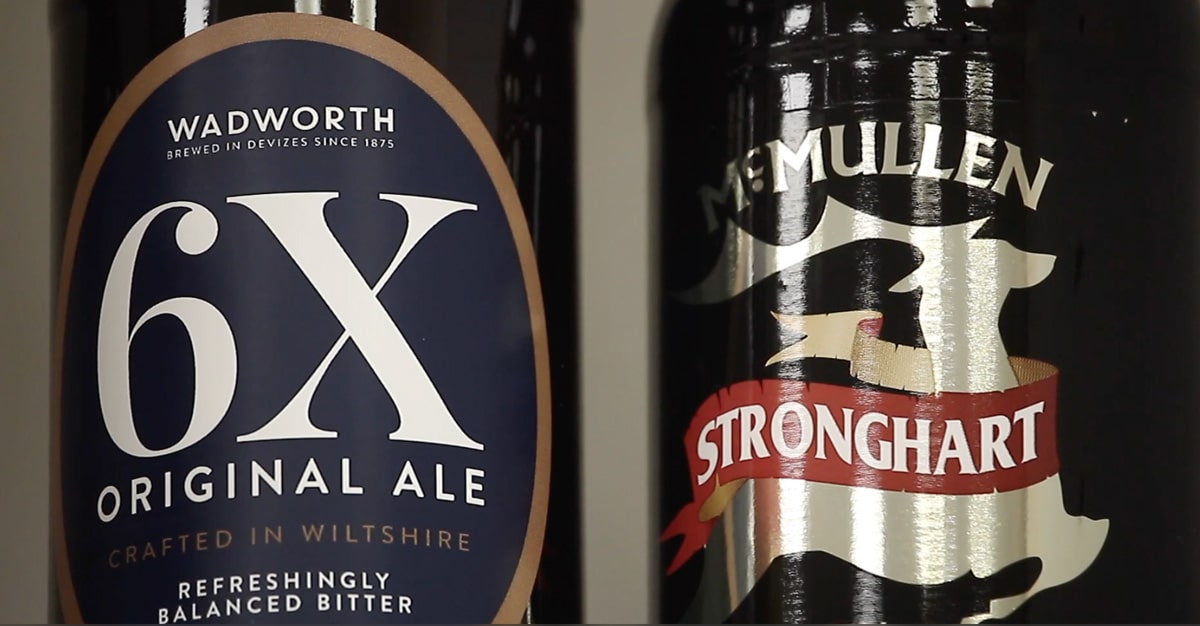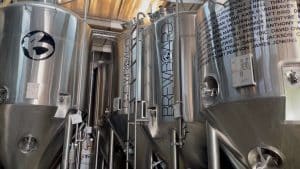
From Field to Fuller’s: The Story of Our Chocolate Malt in London Pride
It’s with great pleasure that we premiere our ‘Field to Fuller’s’ journey, documented by our Northern Irish distribution partners, Get Er Brewed.


by James Marinos
After the Summer barley harvest is complete, the next stage of the journey for the French & Jupps expert maltsters is selecting the finest barley to convert into malt.
In this latest video Doug Horton, Business Development Manager & Paul King, Managing Director at French & Jupps take a deeper dive into the process.
Additional insights shared include an overview of some of the finest specialist malts from the French & Jupps range used to create a special seasonal porter beer by Hadham Brewery.
Video interview with: Doug Horton, Business Development Manager, French & Jupps | Paul King, Managing Director, French & Jupps
Insights discussed include: Sourcing | malt & barley varieties | processing | uses & products | malt testing | specialist beer malts | flavour profiling | beer tasting.
Transcript
[00:00:26.520] – James Marinos
I’m here at the French and Jobs headquarters in Stansted Abbotts, Hertfordshire in the boardroom to meet with their expert, Maltsters, to discuss the conversion process of barley into malt, before reaching your glass.Before reaching your glass,
[00:00:40.460] – Doug Horton
I’m Doug Horton. I work here at French and Juppd Maltings. I’m the business development manager. The barley we use is all locally sourced. There’s no point in bringing barley from miles away. It’s not economically sound, and it’s also not good for the environment. Here in the Southeast of Britain is where most of the grain in the country is grown. So that’s where the best malting barley is grown. That’s why we’re here as a maltings. The varieties we use are recommended varieties by NIA National Institute of Agricultural Botany. And they recommend the varieties through plant breeders and so on. And we only use specific varieties of barley to make our malt. The recommended varieties and because we roast them in and it’s a harsh process, we only use winter sewn barleys. And over the years the change. There’s been literally hundreds in the years I’ve been here.
[00:01:39.800] – James Marinos
I didn’t know there’s so many varieties, I think we’ve seen a few here today. So at Watton-at-stone what was was being grown was Carat Barley
[00:01:48.900] – Doug Horton
Yeah. Is a winter variety. We can’t use spring varieties at all. The process is quite harsh and we need it to retain the skin. So when we liquify in the roasting process, it doesn’t all burst out and make a big mess in the roasting drum. So that’s why we use winter varieties. The skin is better retained, as opposed to spring varieties.
[00:02:13.360] – James Marinos
What is the malt primarily used for? Is it simply beer is there quite a cross range of markets?
[00:02:20.760] – Doug Horton
It goes into a lot of products and it was surprise you how many products it goes into? Anything with the prefix malt whiskey, malt vinegar, maltbread, Maltesers malt will go into. But there’s a lot of other products that use the word malted milk biscuits, malted shreddies. But then there’s a lot more where you don’t realise Malt goes into, like Bisto gravy granules, Coleman’s packet mixes, that sort of thing. And it’s all different types of malt. You can have whole grain mould that the brewers use. They just lightly crack it and use it that way. You can make it into a flour and then replace wheat with flour. I make malt bread or some of our customers. They turn it into a malt syrup. And that syrup is used to replace sugar syrups in foods. It’s much more natural and less harmful to you. So it’s a much better product in that, and it adds colour as well. Coca Cola, drinks like that can use it.
[00:03:27.080] – James Marinos
Now. I know that French and Jupps history dates back some 300 years, so I was wondering, is there anything which stands out about the process in the way you malt barley perhaps some traditional methods, that you might use?
[00:03:44.200] – Doug Horton
The only traditional method we now still use is the patent method of roasting malt, times have changed. The drums were small and hand turned in 1700s and they were heated up using coal or wood. Well, nowadays the drums are driven by large electricmMotors and the heat source is natural gas. So it’s changed over the years, but it’s still the basic same process the same way you make them malt
[00:04:16.900] – James Marinos
Brilliant, of these three is the Brown malt is one of the patent malts.
[00:04:23.470] – Doug Horton
The brown and the black are both patent malts. The crystal is made completely differently to the patent malt. It’s a lot sweeter crystal malts and caras are a lot sweeter.
[00:04:35.120] – Doug Horton
Here in front of us. We’ve got three malts, all different colour, which will produce different flavour and different sweetness levels. We have a Brown malt, which is the lowest in colour. The middle one is a Crystal malt, but it’s actually a slightly dark Crystal 200 colour, and on the end is black malt, which is very dark, darkest malt we make.
[00:04:57.700] – Paul King
I’ve been brewing my entire career over 30 years, and Luckily I’ve been able to brew some great beers all over the world. But now I’m here with French and Jupps and enjoying my role as managing director of French and Jupps. I think what we’d like to do is introduce you to three unique malt types. We produce a wide range of mould over 14 malt types, but these three are quite unique and quite special because brewerss would typically use these malts to produce Porter style beers. So that’s what we’ve got today. A nice set of malt types that brewers used for Porter beers. And we’re going to start off with the Extra Dark Crystal malt. This is a very rich crystal malts so very sweet, intensely sweet. Lots of treacle notes coming through and then just below the sweet sugary treacle notes. What you see is real depth of dried fruit coming in and then with a nice subtle nuttiness at the end. So a very unique malt type, I think, goes very well with the Porter style of beer. So we routinely taste the malts, evaluate the malts to ensure we’re hitting the right profile. So we look at the aroma first very much in the same way that you would taste a beer. So you look at the aroma and then from there you will then taste the malt tea that we evaluate. And again, you can see the lovely depth of colour that we have here from the dark Crystal malt.
[00:06:41.480] – James Marinos
Now is a malt tea, is that the actuall terminology that you’d give to actually the tasting process?
[00:06:48.040] – Paul King
Yeah. Essentially, that’s what we’ve made here. So we’ve made a rich malt tea from grinding up the malt sample and then steeping it and then filtering it to produce this rich tea that we’re looking at here. So we moved along now from the extra dark Crystal malt to a Brown malt. Brown malt is quite a special malt, quite rare. You don’t find many maltsters today producing a Brown malt and typically for Porter beers brown malt was the ingredient. It was the key malt that was used to make a Porter beer today has changed slightly. Brewers will use a pale malt and bring in chocolate malts, extrra dark crystal malts and black malts. But historically going back to 17 hundreds, it was Brown malt that was used exclusively in Porter beers. I think what we’re looking for here with Brown malt is much stronger, rich, fresh roasted coffee notes coming out, which are very prominent on the aroma. And also as you taste the malt itself. And that’s what the brewer would be looking for. Some nice depth of coffee character coming out also some delicate chocolate notes, some rich fruit, nice sweetness as well. And also ehat’s very pleasant, is nice fresh breakfast toast as well. So a lovely balanced malt, lots of character and ideal for a rich Porter style of beer. Yeah, this is up black malt and hugely popular moults, both here in the UK but also overseas markets to very popular with craft brewers. A hugely hugely complex malt. And it’s got such an enormous depth of smokiness, very pronounced barbecue coals, very deep, dark in colour, as you can see here, looks quite luxurious. And then what you are seeing behind that immense smokiness up front is is a very pleasant bitterness, which I think brewers find combine well with the hops to give a very, very well balanced beer, but a lovely, lovely malt smokiness breakfast toast grainy but huge, huge character and similar. to perhaps the Brown malt as well. Lovely coffee notes coming through is like almost the very best Espresso you’ve ever tasted right here in a glass. Ok. So looking at a very fine Porter brewed by a local Brewer little Hadham brewery just down the road from us here, and they just do such outstanding job. Making a very special Porter beer. Porter beers areunique we’ve been brewing, I guess, in the UK since the 1700s. So a very historic, I guess get dipped in popularity in the 1800s, but has seen a huge resurgence in recent years, not just here in the UK but also globally, but typically, research in a Port of beer, brewers would have been working exclusively with Brown malt typically, but more recently, recent times the brewers have become perhaps more creative and then are bringing in deeper, darker, malts, your black malt that we’ve looked at earlier, combining it with maybe an extra dark Crystal and maybe an element of Brown Molton there as well to really get the character of the beer thereafter.
[00:10:20.060] – James Marinos
Something really unique!
[00:10:21.460] – Paul King
Absolutely, very unique. But coming through what you can see, you can see that lovely, pleasant smokiness, that rich coffee character coming through that we saw in the malts earlier and also some lovely pleasant, pleasant dried fruits coming through, dates, prunes so well balanced something to savour
[00:10:44.440] – James Marinos
Yeah, absolutely and comparing at least just on the fragrance of this beer alone, some of the malts we’ve just looked at you can really, you can really detect those notes of the dried fruits.
[00:10:59.360] – Paul King
Absolutely. And you talked earlier james. What you see in the Crystal malt. You saw some very rich caramelised sugars coming through. Maybe delicate toffee notes it’s all here. It’s all packed into this wonderful beer.
[00:11:14.130] – James Marinos
It’s wonderful. I think there’s only one thing left to do then.
[00:11:17.480] – All
Cheers

It’s with great pleasure that we premiere our ‘Field to Fuller’s’ journey, documented by our Northern Irish distribution partners, Get Er Brewed.

Ever wondered what goes into a truly special craft beer collaboration? In our ‘Brew Day Secrets’ video, we’ve joined forces with BrewBoard Brewery, Hukins Hops, and The Green Man, Thriplow, for a sneak peek into how our brand-new collaboration beer has been crafted!

South Cambridgeshire’s BrewBoard brewery and The Green Man pub in Thriplow are raising a glass to tradition with a local collaboration, uniting with French & Jupps and Hukins Hops, to create a unique beer that tells a story ‘full circle’ of local provenance.
We’d love to become part of your journey and for you to become part of our story.
If you are looking to create your project using the finest malt with beautiful flavours and aromas, please get in touch,
French & Jupps Ltd, Roydon Road, Stanstead Abbotts, Herts, SG12 8HG
Registered Company No. 00165116
To learn about the journey from field to glass and more detailed explanation of the malting process click below.
Proudly delivering outstanding quality and services for centuries to come.
We pride ourselves in:
Producing the finest quality speciality malts
Providing an inspiring environment for businesses to develop and grow
Supporting the community and local youth programmes
Family owned and driven by core family values.
We are: One team, supportive, honest, respectful and care greatly about our community, local talented youth and the environment.
French & Jupps Ltd, Roydon Road, Stanstead Abbotts, Herts, SG12 8HG